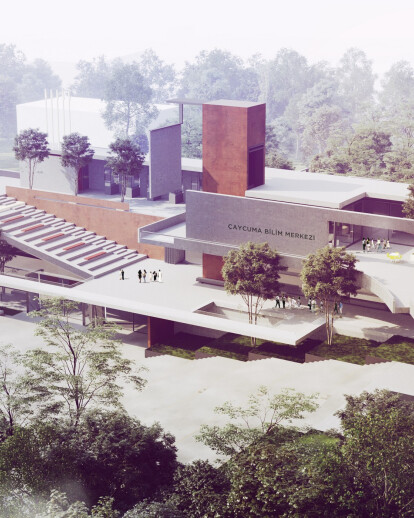ABOUT THE COMPETITION The Çaycuma Science Center Architectural Competition was an open architectural competition organized by Çaycuma Municipality, a town in the Black Sea region of Turkey. A 2000 square meters science center was asked to be designed on a site with dense forest texture where a portion without trees also existed. The proposal by ONZ Architects won the second honorable prize among seventy seven projects which applied for the competition.
ARCHITECTURAL BRIEF With the dream of a science center where people of all ages, but especially children can learn while having fun, question things and get excited in their search for answers, where they can explore new horizons while experimenting and sharing with others, as a starting point, the project aims to reflect this enthusiasm and excitement architecturally. One of the main objectives of the design is to involve nature into this process and to add another important stop on this journey of scientific discovery. The green texture of the competition site features a significant potential in this respect. The design, by protecting all the trees on the site and by adding new ones to the green texture, creates an environment for scientific quests that is surrounded by nature.
In Caycuma Science Center project, the flow of indoors and outdoors, and relationship with nature have been prioritized. By flowing onto each other the lower square, urban platform and outdoor exhibition areas constitute a dynamic experience for the visitors.
The sheltered lower square, away from the traffic and urban hustles, creates a public space where the visitors can relax surrounded by green, away from stress and noise of the city, and where children can play safely.
The urban platform and lower square besides being a significant urban value for the city, contribute to circulation flexibility of the Science Center. The urban platform invites the visitors in the building through the same level from the adjacent road or, when continued from outside takes them to the open air amphitheater.
This amphitheater also supported by the café upstairs, enables the users to enjoy a cup of coffee together or watch a movie or a scientific performance. The accessibility and flow of open platforms render this building an attraction spot not only for the functions it houses inside but for the shared public life; an enjoyable space to go and relax, chat with friends and breathe in the urban atmosphere.
The science center is a multi-functional building, in which the subunits such as temporary and permanent exhibitions, educational units, outdoor exhibition areas, the Foucault pendulum and the natural spaces are located in such a manner that allows the distribution of crowded visiting groups in the building without disturbing each other. The access to the building is provided from two different levels. This division allows different units to serve independently, yet all units are connected from both interior and exterior. The service spaces and service entrance are located at the east façade, and the façades facing nature host the public activities. Thus the public life and the green texture are carried through the building via urban platforms.
The permanent exhibition hall can be directly accessed from the lower square. Service spaces and storage units are mostly located on this level. The service entrance is from the east façade in order not to block the visitor circulation. The outdoor exhibition hall is directly connected to the exhibition hall. The exhibition hall’s enclosed west façade and the homogeneous natural light coming from the opening at the north façade enables an easier perception of the exhibited material.
The temporary and permanent exhibition halls with the volume featuring the Foucault Pendulum continues through all floors. The double height and the L shaped volumes in these spaces create a visual and physical continuity. The Foucault Pendulum, which holds a significant importance for the center, can be viewed from the lower floor, upper floor, outdoors and the upper platform. Besides the symbolic value of the pendulum, its visibility and perceptibility from all interior and exterior spaces becomes important because the pendulum’s swing takes a long time. Having a continuous connection with the exhibition halls, the interior and exterior public and recreational spaces, the changes on the pendulum’s swing caused by the rotation of the Earth can be followed constantly while visiting the museum.
As a unit to direct and inform the users about the city and the science center, the Visitor Center proposed additionally to the program is designed at the upper level. This center with a separate entrance is connected to the rest of the building via the urban elevator and the urban platforms. This space can also be used as an expansion for the temporary exhibition hall or an exhibition space for the products designed in the educational units if needed. The urban elevator connecting all levels is not only a vertical circulation element but a landmark for the Science Center.
Educational units are positioned at the upper floor in order to provide an isolated study environment for users. These units procure a controlled and quiet ambiance with the exclusive inner courtyard while being in touch with the whole building. Fully operable façade design of the inner courtyard provides a flexible system that can expand the multi-purpose hall and the classrooms when needed. The pedestrian bridge that leads visitors from the educational units to the green is designed to support the education by experiencing nature first hand. With this bridge, the educational units can also function independently from the rest of the building.





























